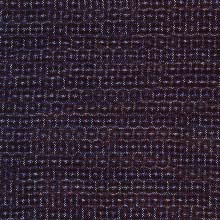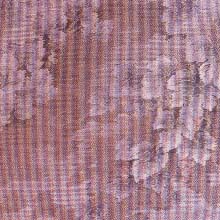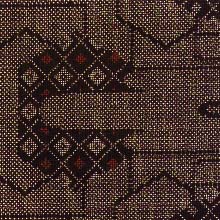Weave (p. 130 )
1. Produced in Amami-Islands Oshimagun, and Kagoshima City, Kagoshima Prefecture.
2. Characteristics: A plain woven silk fabric with pre-dyed scoured threads both for warp and weft. The color is refined and calm and the fabric is soft and difficult to wrinkle. Threads are dyed with plant dyes such as "Techiki" (Raphilolepis umbellata) and indigo (Persicaria tinctoria) with a technique, peculiar only to "Oshima Tsumugi," called "Ori Jime." As a variety, an additional treatment is made to the dyed thread by dipping them in muddy water. It is "Doro(mud) Zome(dyeing)." There are several kinds of "Oshima Tsumugi":"Doro Oshima," "Ai(indigo) Oshima," "Doro Ai Oshima," "Iro(color) Oshima" and "Natsu(summer) Oshima."
3. Uses: Clothing.
4. History: Judging from some of the spindles which were excavated from the ruins of the Yayoi Period(ca. 300 BC-ca. AD 300), the people in the Amami Islands were weaving for a long time. It is said that "Oshima Tsumugi" was originated from the fabric transported from China one thousand and several hundred years ago, or that it was brought from Kume Island in Okinawa. It is certain that sericulture was popular and "Tsumugi" was woven with hand spun threads during 710-94. During 1716-36, "Kasuri Tsumugi"(splash pattern pongee) was popular here. It was woven with hand dyed threads. However, all of the Tsumugi were not in use for the general people because the islanders were prohibited to wear silk clothing. The Tsumugi was only an item used to pay taxes to the feudal government. It was only after the Meiji Restoration that the Kasuri Tsumugi became a commodity for trading. The Oshima Tsumugi produced by "Doro Zome" was born in 1878. A village housewife happened to find the reddish brown(dyed with "Techiki") change to gray while the dyed cloths were dipped for washing in the rice paddy water. This is the beginning of the Doro Oshima. As a result of studies, patterns also developed from a simple "Tate-Yoko(warp and weft) Kasuri" to "Juji(cross) Kasuri" and "Kikko(tortoise shell, hexagonal) Kasuri." Around 1900 a man invented a new technique called "Ori(weaving) Jime," using a loom to dye threads. The technique enabled the production of varieties of Kasuri designs, resulting in an increase of the demand. Accordingly, the loom changed from "Jibata"(loom with no pedestals) to "Takahata"(high loom) which is more effective in weaving. Thus the Oshima Tsumugi won the reputation as the high quality fabric for clothes with precise designs. "Ai(indigo) Oshima" was first produced in early Taisho(1912-26) and "Iro(color) Oshima," in which chemical dyes are partially used, in early Showa period(1926-89) .
Dyeing Method
1. "Doro Oshima Tsumugi" (1) Threads dyeing: Enriched liquid is obtained after boiling the trunk of "Techiki" in the water for about 10 minutes. Threads are dipped in the cooled liquid and crumpled by hand with a small amount of lime for about 15 minutes, and then dried in the sun. The process is repeated about 20 times. (2) "Doro Zome": Threads are dipped in ferrous muddy water and immersed well by crumpling, so that the color of the threads changes into brown. The details are: (a) " Techiki dyeing" 3 times, (b) mud dyeing once, (c) washing in the water, (d) "Techiki dyeing." After this process, "Techiki dyeing" is made 20 times and "mud dyeing" is made once. After several ten times of the repetition of the above process, the threads become dark brown and more pliant. (3) "Shiro Oshima": Fabric woven with threads which are dyed with white mud of the volcanic ashes of Mt. Sakurajima, an active volcano in Kagoshima Prefecture.
2. "Ai Oshima Tsumuki": Threads are dyed in indigo and patterns are left white.
3. "Doro Ai Oshima Tsumugi": Threads are dyed in light blue first and then both "Techiki dyeing" and "mud dyeing" are applied to them.
4. "Iro Oshima Tsumugi": Variety of "Doro Oshima" and "Ai Oshima." Red, yellow and green are added to them by chemical dyes.





